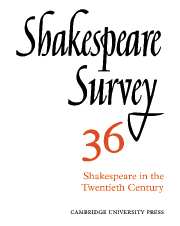Book contents
- Frontmatter
- Shakespeare and the Living Dramatist
- Blood and Wine: Tragic Ritual from Aeschylus to Soyinka
- Hamlet Andante/Hamlet Allegro: Tom Stoppard’s Two Versions
- Auden, Shakespeare, and the Defence of Poetry
- Graves on Lovers, and Shakespeare at a Lovers’ Funeral
- Tragic Balance in Hamlet
- Hamlet Across Space and Time
- Shakespeare’s Scripts and the Modern Director
- ‘He Shall Live a Man Forbid’: Ingmar Bergman’s Macbeth
- Komisarjevsky at Stratford-upon-Avon
- Troilus and Cressida and the Definition of Beauty
- The Pastoral Reckoning in Cymbeline
- New Created Creatures: Ralph Crane and the Stage Directions in The Tempest
- Arden of Faversham
- ‘Pickleherring’ and English Actors in Germany
- Shakespeare Performances in Stratford-upon-Avon and London, 1981–2
- The Year's Contributions to Shakespearian Study 1 Critical Studies
- 2 Shakespeare’s Life, Times and Stage
- 3 Textual Studies
- Index
- Plate Section
Arden of Faversham
Published online by Cambridge University Press: 28 March 2007
- Frontmatter
- Shakespeare and the Living Dramatist
- Blood and Wine: Tragic Ritual from Aeschylus to Soyinka
- Hamlet Andante/Hamlet Allegro: Tom Stoppard’s Two Versions
- Auden, Shakespeare, and the Defence of Poetry
- Graves on Lovers, and Shakespeare at a Lovers’ Funeral
- Tragic Balance in Hamlet
- Hamlet Across Space and Time
- Shakespeare’s Scripts and the Modern Director
- ‘He Shall Live a Man Forbid’: Ingmar Bergman’s Macbeth
- Komisarjevsky at Stratford-upon-Avon
- Troilus and Cressida and the Definition of Beauty
- The Pastoral Reckoning in Cymbeline
- New Created Creatures: Ralph Crane and the Stage Directions in The Tempest
- Arden of Faversham
- ‘Pickleherring’ and English Actors in Germany
- Shakespeare Performances in Stratford-upon-Avon and London, 1981–2
- The Year's Contributions to Shakespearian Study 1 Critical Studies
- 2 Shakespeare’s Life, Times and Stage
- 3 Textual Studies
- Index
- Plate Section
Summary
We do not know who wrote Arden of Faversham, but we know that it belongs to the late 1580s or early 1590s, a period when new and often ambitious talents were appearing and when dramatic genres were being self-consciously shaped and reshaped. It was a time when playwrights were staking out their territory, as Marlowe does in his Prologue to Tamburlaine the Great, a play roughly contemporary with Arden:
From jigging veins of rhyming mother-wits
And such conceits as clownage keeps in pay,
We’ll lead you to the stately tent of War,
Where you shall hear the Scythian Tamburlaine
Threat’ning the world with high astounding terms
And scourging kingdoms with his conquering sword.
View but his picture in this tragic glass
And then applaud his fortunes as you please.
The play is going to be exotic, heroic, exalted in language, tragic in dignity. The author of Arden of Faversham gives us a similar statement, staking out a very different territory:
Gentlemen, we hope you’ll pardon this naked tragedy
Wherein no filèd points are foisted in
For simple truth is gracious enough
To make it gracious to the ear or eye;
And needs no other points of glozing stuff.
(Epilogue, 14–18)- Type
- Chapter
- Information
- Shakespeare Survey , pp. 121 - 134Publisher: Cambridge University PressPrint publication year: 1983
- 1
- Cited by



